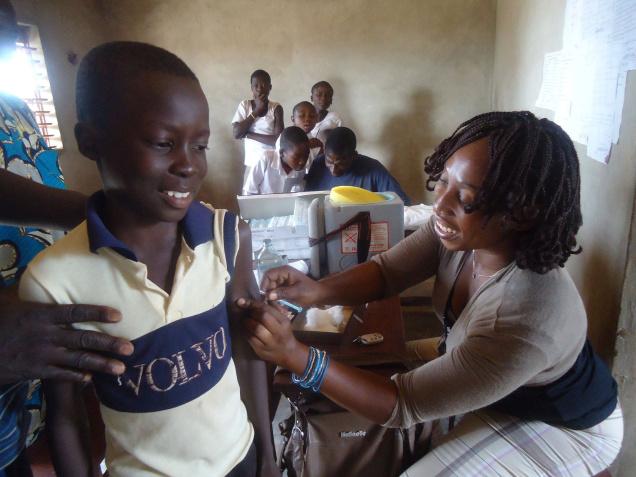
“It’s a great Indian success story,” said Dr. Jacob John, a former virologist of the Christian Medical College (CMC), Vellore. He was referring to MenAfriVac, a meningitis A vaccine manufactured by the Pune-based Serum Institute of India. The vaccine passed the litmus test during a large-scale vaccine campaign in Banikoara district in the Republic of Benin, West Africa.
In the first-ever use in a developing country, the vaccine remained stable outside the cold chain at temperatures not exceeding 40 degree C for not more than four days. The vaccine should normally be kept in a cold chain at 2-8 degree C. The results of the vaccination programme funded by GAVI and WHO/PATH (which also provided training, supervision, evaluation) were published recently in theVaccine journal.
An independent body under the guidance of the Ministry of Health in Benin conducted active monitoring for adverse events following immunization (AEFI) by comparing the rate and severity of AEFIs in the study area and a control area. “The results of the study, which have been submitted for publication, indicated there was no increase in AEFIs with the CTC practice, and no serious AEFIs reported at all,” Dr. Simona Zipursky, first author of the paper from OPTIMIZE, a WHO/PATH Collaboration, Switzerland noted in an email to this Correspondent.
The fact that controlled temperature chain (CTC) would increase the efficiency of the vaccination campaign was amply demonstrated in Banikoara district, Benin — about 1,50,000 people aged 1-29 years were vaccinated for meningitis A from November 15-25, 2012.
The CTC vaccine greatly helped in increasing vaccination coverage in a few areas where access was a problem and electricity was unreliable. According to the paper, the health workers stayed in the villages for three consecutive days before returning for a refill.
“100 per cent of the vaccinators surveyed felt CTC was either ‘extremely’ useful or ‘relatively useful’. They reported that the biggest benefit from the CTC practice was the fact that it enabled them to vaccinate more people. Other key benefits included: no need to return to health centre every night (hence, able to reach more remote areas), reduced logistic burden (no need to worry about cold chain or ice packs) and reduced wastage,” said Dr. Zipursky.
Another big advantage is the huge savings in cost. “A study published in the WHO bulletin showed that using a CTC approach can reduce the cold chain related campaign costs by 50 per cent. To put it in perspective, for the remaining MenAfriVac campaigns between 2014 and 2016, [the savings would translate] to over $12 million dollars,” Dr. Zipursky noted.
The vaccine was originally meant to be kept at 2-8 degree C at all times. But WHO approved the CTC use after Serum Institute successfully demonstrated its stability and potency even when exposed to higher temperatures. According to the paper, this was the first time WHO had approved a vaccine to be used at ambient temperature in developing countries
“Even prior to the request, we had done trials of up to 40 degree C,” said Dr. Suresh Jadhav, Executive Director of Serum Institute. “As it is a heat-stable vaccine, we wanted to see if it remains potent even when exposed to 40 degree C.”
But the test period was restricted to one week. “We conducted this study even when it was not required,” he said. But the duration of test was extended to one month when the company was requested to test its stability and potency when exposed to 40 degree C.
“We found the potency was getting reduced after three weeks [of exposure to 40 degree C],” Dr. Jadhav said. “But there was a clear indication that the concept worked.”
The reason why the vaccine remains stable even at 40 degree C is because the freeze drying of the vaccine makes it heat stable or thermostable.
The 40 degree C upper temperature limit has come as a boon to people in the sub-Saharan African belt where about 200,000 people suffer from meningitis every year during the dry season when wind spreads the bacterial spores. Mortality is about 10-15 per cent and morbidity is very high.
“The ambient temperature reached [during the campaign] was 39 degree C,” Dr. Zipursky noted. “Luckily in the African meningitis belt, temperatures during the MenAfriVac campaign season are usually below 40 degree C.”
The dry season during January to June throughout the sub-Saharan belt is when meningitis outbreaks occur. “MenAfrivac has been introduced in 12 countries just before the dry season (November/December since 2010) to protect populations before the meningitis season,” Dr. Olivier Ronveaux, from the Meningitis Focal Point, Control of Epidemic Diseases Team, WHO, Geneva noted in an email.
Besides other huge gains, the cost of the vaccine per se is incredibly low. According to Dr. Jadhav, the cost of one dose is just $0.60 cents (Rs.36). A polysaccharide vaccine, on the other hand, cost about $5 dollars and is not effective as the polysaccharide provides only short-term immunity and hence given during an epidemic. MenAfriVac vaccine is a polysaccharide conjugate vaccine.
“There is a great sense of satisfaction… there is a great sense of achievement,” said Dr. Jadhav “as you can not only save lives but also avoid morbidity.”
source: http://www.thehindu.com / The Hindu / Home> S & T> Health> Medicine / by R. Prasad / March 05th, 2014